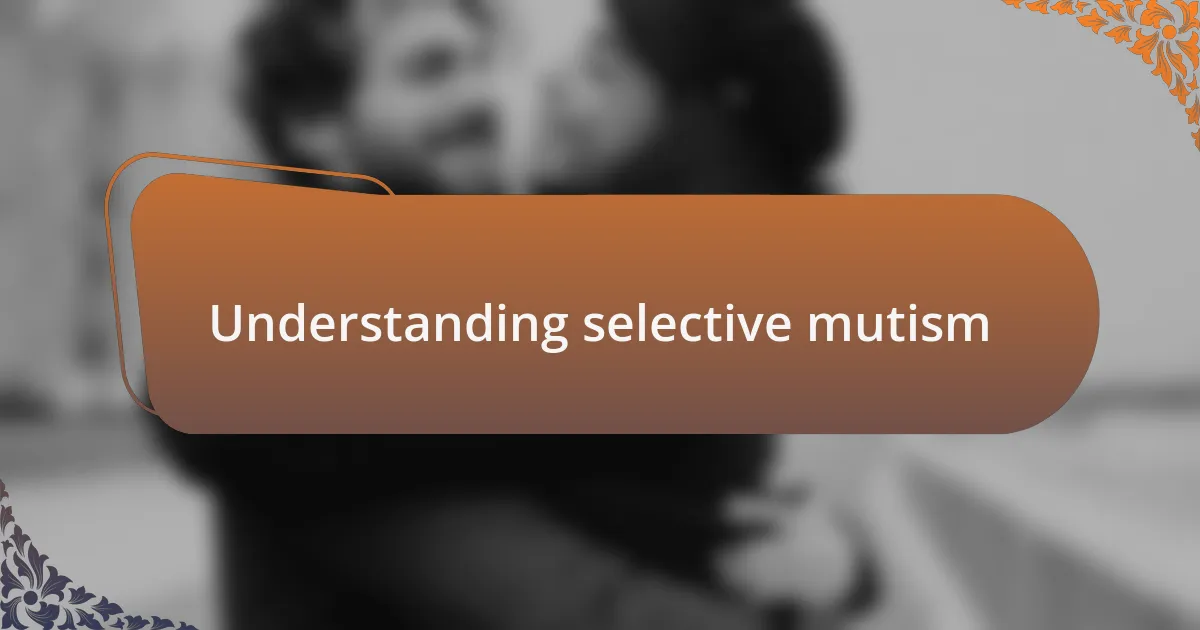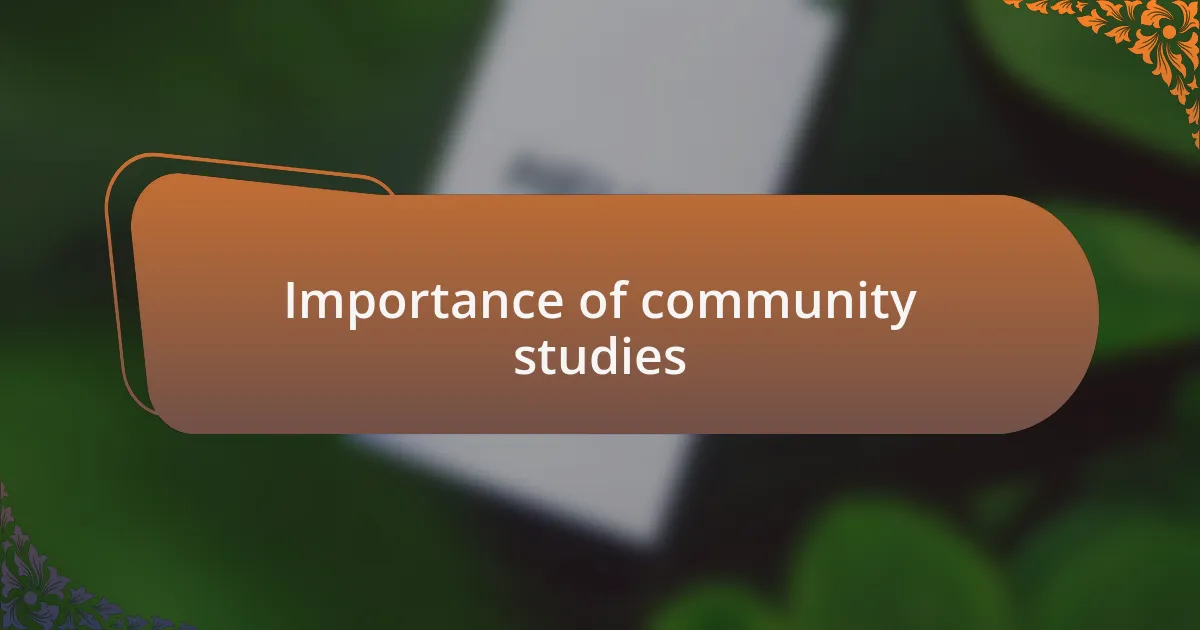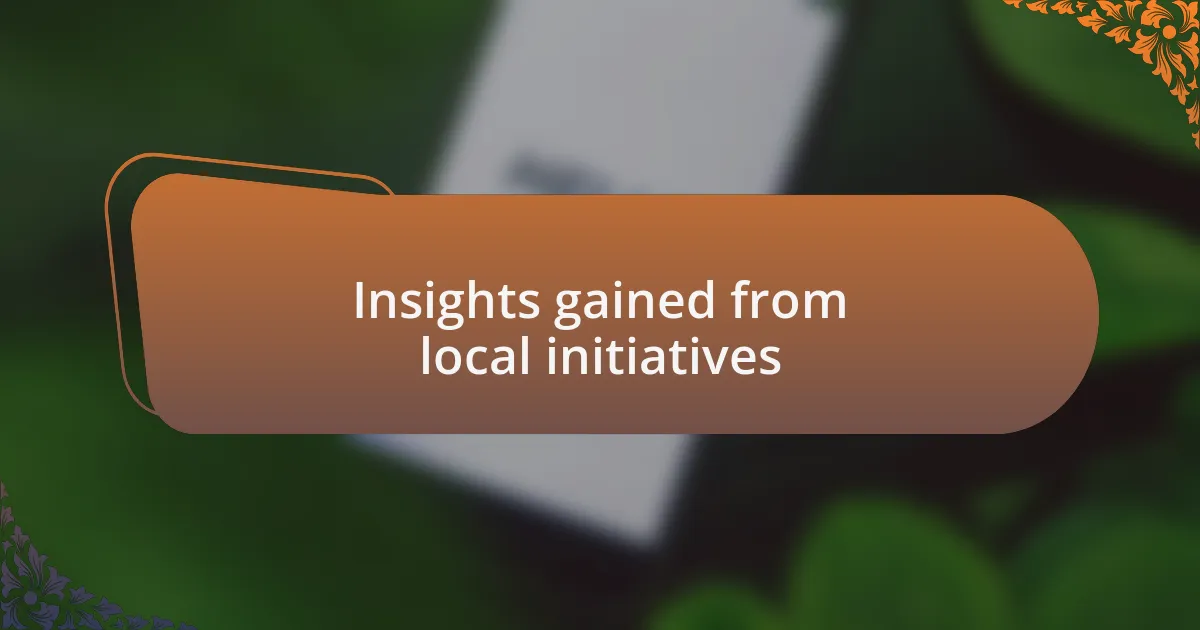Key takeaways:
- Selective mutism is a complex anxiety-driven condition that affects social interactions and requires compassionate support from the community.
- Community studies and initiatives foster collective awareness and collaboration, providing tailored interventions that benefit children and families dealing with selective mutism.
- Personal experiences and shared stories within supportive environments highlight the importance of patience and trust in helping children find their voice.
- Engaging strategies, such as art projects and workshops, significantly raise awareness and create supportive networks for families navigating selective mutism.

Understanding selective mutism
Selective mutism is often misunderstood as mere shyness, but it’s far more complex. I remember meeting a child who would light up when chatting with his stuffed animals but would freeze in silence around peers. It made me wonder, what does it feel like to have so much to say but feel completely blocked in the moment?
This anxiety-driven condition can severely impact social interactions and educational experiences. Imagine standing in a crowded classroom, filled with eager faces, yet feeling an overwhelming sense of isolation because words just won’t come. I often reflect on how crucial it is for us to create environments where these children feel safe enough to express themselves without fear of judgment.
Understanding selective mutism means recognizing the underlying emotional turmoil. It’s not simply a choice; it’s a barrier rooted in anxiety. I’ve seen how supportive interventions can protect a child’s spirit, allowing them to slowly find their voice. Isn’t it essential for us as a community to compassionately support not just the child, but their entire family as they navigate this journey?

Importance of community studies
Community studies hold immense value in understanding and addressing issues like selective mutism. From my perspective, these studies foster a collective awareness that goes beyond individual experiences, allowing us to see patterns and shared challenges that kids face. For instance, when I participated in local support groups, I noticed that families often felt isolated in their struggles, but together, they found strength and hope. Isn’t it remarkable how a sense of belonging can transform a daunting journey into a shared mission?
The insights gained from community studies can guide interventions tailored to specific needs. I recall being part of a workshop where we discussed various strategies for helping children communicate. It was touching to hear parents share their stories, each resonating with the others, leading to some of the most practical solutions. This experience taught me that insider perspectives truly shape effective approaches. How can we better tailor our resources if we don’t listen to those directly impacted?
Moreover, community studies act as a bridge between professionals and families, fostering collaboration that enhances understanding. I once attended a seminar where educators and therapists came together to hear parents’ perspectives on selective mutism. The emotional exchanges highlighted a gap in knowledge that we, as a community, need to fill. By actively engaging with one another, we can create informed strategies that benefit everyone. Don’t you think our collective efforts can spark real change when we all come to the table?

Insights gained from local initiatives
Local initiatives have provided invaluable insights into the importance of community support for children with selective mutism. I remember visiting a local school where teachers had implemented a quiet corner, a safe space for children to express themselves when feeling overwhelmed. Observing the children interact in this calm environment demonstrated to me how small adjustments can create a nurturing atmosphere. Isn’t it inspiring how localized changes can significantly impact children’s comfort levels?
One initiative I participated in was a grassroots project that encouraged neighborhood parents to share experiences and resources. The shared stories helped me realize that while every child is unique, the feelings of anxiety and isolation are often universal. Listening to a parent describe the sheer relief of finding others who understood their journey truly opened my eyes to the strength we can draw from connecting with people facing similar challenges. How much more empowering can it be when we understand we’re not alone?
Additionally, community events have highlighted the vital role of collaboration among families and professionals. At a local fair, I witnessed speech therapists and parents brainstorming interactive activities together, leading to remarkable ideas that could cater to children’s specific needs. This collaborative spirit not only gave parents a sense of ownership but also created pathways to solutions that professionals might not have considered otherwise. Isn’t it powerful how collaboration can ignite creativity and foster innovative approaches?

Personal experiences with selective mutism
Watching a child navigate selective mutism can be both heartbreaking and enlightening. I recall attending a support group where a young girl slowly opened up to the facilitator after several sessions of silence. It was incredible to see how trust was built over time, reinforcing the notion that patience is crucial in this journey. Have you ever witnessed such a breakthrough? It’s a reminder that every small step forward deserves celebration.
In another instance, I attended a workshop focused on techniques to encourage verbal communication. One of the exercises involved role-playing scenarios that might trigger anxiety for a child with selective mutism. Engaging in these simulations allowed me to feel the tension and apprehension that these children experience. It dawned on me how vital it is to create a supportive environment where they can feel safe to express themselves. How can we create more of these spaces in our communities?
Reflecting on my own encounters, I’ve often marveled at the depth of connection that emerges when sharing personal stories. During an informal gathering, one parent shared how her son found comfort in writing, which eventually helped him verbalize his thoughts. Listening to her describe the transformation brought tears to my eyes. It made me realize that sometimes, self-expression takes forms we least expect. Isn’t it fascinating how discovery can arise through a child’s perspective?

Strategies for raising awareness
Raising awareness about selective mutism requires creative and engaging strategies. I once participated in a community art project where children expressed their feelings through painting and drawing. This experience opened my eyes to the power of non-verbal expression, demonstrating how art can serve as a bridge to communication. Have you ever thought about how colors and shapes can convey what words sometimes cannot?
Organizing informational workshops can also be transformative. I remember a local event where experts shared insights about selective mutism with both parents and educators. The conversations that followed were deeply impactful. Not only did it help demystify the condition, but it also fostered a sense of community and support. How can we replicate that atmosphere in other settings?
Utilizing social media is another vital strategy for spreading awareness. I often share personal stories and resources on my platforms, which has attracted a supportive online community. The feedback from parents detailing their own experiences highlights a collective understanding. Isn’t it uplifting to know that we can connect with so many people who care about advocating for these children?

Supporting families in the community
Supporting families in the community involves creating a network of resources and emotional support. I recall a heartwarming moment at a local support group where parents exchanged not just information, but their fears and triumphs. It reminded me how powerful shared experiences can be in lightening a family’s burden. Have you ever felt lighter just by sharing your story with others?
Another effective method is offering community play dates specifically designed for children with selective mutism. I organized one such event, and witnessing the children begin to interact in their own way was profoundly moving. The laughter and creativity flowed freely, showing that connection doesn’t always need words. How can we create more spaces where kids feel safe to express themselves?
Additionally, resources tailored to families, like brochures or online forums, can make a significant difference. I once stumbled upon an online group where parents addressed their concerns about school integration for their children. This community provided not just insights but also hope, reminding me that every family navigates this journey together. Isn’t it reassuring to know that support is just a click away?